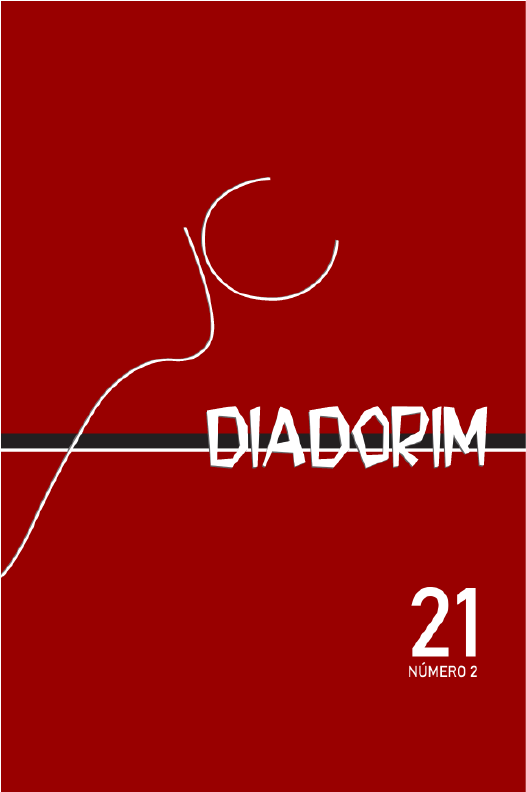DIFERENÇAS SEMÂNTICAS DE MICROCONSTRUÇÕES QUANTIFICADORAS: O CASO DE SN1 DE SN2
DOI:
https://doi.org/10.35520/diadorim.2019.v21n2a27247Palavras-chave:
Construções binominais quantitativas, quantificação, Gramática de Construções Baseada no Uso.Resumo
Este trabalho consiste em um estudo de construções binominais quantificadoras do tipo SN1 de SN2 no português brasileiro sob a ótica da Linguística Baseada no Uso (Bybee, 2010; Barlow; Kemmer 2000; Boyland, 2009), associando os pressupostos da Gramática de Construções (Goldberg, 2006; Diessel, 2015; Hilpert, 2014; Perek, 2015) com o Modelo de Exemplares (Bybee, 2006; 2010; 2013; Pierrehumbert, 2001). Com o intuito de descrever o modo como ocorre a distribuição dessas construções no uso da língua, nós comparamos quatro microconstruções quantitativas, a saber DET monte de SN, DET montanha de SN, DET enxurrada de SN e DET chuva de SN, em relação às quais foi realizada uma análise colexêmica (GRIES; STEFANOWITSCH, 2004). Os resultados indicaram que as referidas microconstruções, que se assemelham funcionalmente, possuem preferências colocacionais próprias, as quais foram associadas à maior ou menor coerência semântica entre os nomes das colocações encontradas. Por exemplo, enquanto a microconstrução DET monte de SN recruta preferencialmente nomes mais genéricos, DET montanha de SN prefere SN cujo referente apresentem a propriedade de ser mais empilhável ou que estejam organizados de forma aglomerada.
Referências
ALONSO, K. S. B.; LEITE DE OLIVEIRA, D.; FUMAUX, N. C. A, NASCIMENTO, G.F; SILVA, T. M. Quantifying binominal constructions in Portuguese and Russian: the case of um monte de NP and kucha NPgen. (no prelo)
BARLOW, M.; KEMMER, S. (orgs.). Usage based models of language. Stanford, California: CSLI Publications, 2000.
BYBEE, J. From usage to grammar: the mind’s response to repetition. Language, v.82, n.4, p. 711-733.
BYBEE, J. Language, usage and cognition. New York: Cambridge University Press, 2010.
BYBEE, J. Usage-based Theory and Exemplar Representations of Constructions. In: HOFFMANN, T.; TROUSDALE, G. The Oxford Handbook of Construction Grammar. Oxford: University Press, 2013, p. 49-69.
BYBEE, J.; BECKNER, C.; BYBEE, J. A. A usage-based account of constituency and reanalysis. in: Ellis, n. c.; Larsen-freeman, d. (eds.). Language as a complex adaptive system. boston, ma: wiley-blackwell, 2009. p.27-46.
BOYLAND, J. T. Usage-based models of language. In: Eddington, D. (ed.). Experimental and Quantitative Linguistics, Munich: Lincom, 2009, p. 351-419.
DIESSEL, H. Usage-based construction grammar. In: Dabrowska, E.; Divjak, D. (eds.). Handbook of Cognitive Linguistics. Berlin: Mouton de Gruyter, 2015.
ELLIS, N. C.; LARSEN-FREEMAN, D. (eds.) Language as a Complex Adaptive System. Language Learning, n. 59, Suppl. 1, 2009.
FRANCIS, E. J., MICHAELIS, L. A. (orgs.). Mismatch: form-function incongruity and the architecture of grammar. Stanford, CA: CSLI Publications, 2003.
FUMAUX, N. C. A. Construcionalização de DET monte de SN: uma abordagem centrada no uso. Dissertação (Mestrado em Linguística) do Programa de Pós-graduação em Linguística, Faculdade de letras, UFRJ, Rio de Janeiro, 2018.
GOLDBERG, A. E. Constructions at work: the nature of generalization in language. Oxford: Oxford University Press, 2006.
GRIES, S. Th. Coll.analysis 3.5. A script for R to compute perform collostructional analyses, 2014.
GRIES, S.; Stefanowitsch, A. Extending collostructional analysis. A corpus-based perspective on ‘alternations’. International Journal of Corpus Linguistics 9:1, 2004, p. 97-129.
HILPERT, M. Construction Grammar and its Application to English. Edinburgh: Edinburgh University Press, 2014.
HOPPER, P. J. Emergent Grammar. Proceedings of the Thirteenth Annual Meeting of the Berkeley Linguistics Society. Berkeley Linguistics Society, 1987, pp. 139-157.
LAKOFF, G., JOHNSON, M. Metaphors we live by. Chicago/London: University of Chicago Press, 1980
LEVISHINA, N. How to do Linguistics with R: Data exploration and statistical analysis. Amsterdam: John Benjamins, 2015.
PIERREHUMBERT, J. Exemplar dynamics: Word frequency, lenition and contrast. In:
BYBEE, J.; HOPPER, P. (ed.) Frequency effects and the emergence of linguistic structure, p. 1-19.
Amsterdam: John Benjamins, 2001.
PEREK, F. Argument structure in usage-based construction grammar: Experimental and corpus-based perspectives. Amsterdam: John Benjamins, 2015.
TRAUGOTT, E. C.; TROUSDALE, G. Construcionalization and Constructional Changes. Oxford: University Press, 2013.
ZHAN, F.; TRAUGOTT, E. C. The constructionalization of the Chinese cleft construction. In: Studies in Language. N. 39. John Benjamins Publishing Company, 2015.
Downloads
Arquivos adicionais
Publicado
Edição
Seção
Licença
Transferência de direitos autorais - Autorização para publicação
Caso o artigo submetido seja aprovado para publicação, já fica acordado que o autor autoriza a UFRJ a reproduzi-lo e publicá-lo na Diadorim: Revista de Estudos Linguísticos e Literários, entendendo-se os termos "reprodução" e "publicação" conforme definição respectivamente dos incisos VI e I do artigo 5° da Lei 9610/98. O artigo poderá ser acessado pela internet, a título gratuito, para consulta e reprodução de exemplar do artigo para uso próprio de quem a consulta. Essa autorização de publicação não tem limitação de tempo, ficando a UFRJ responsável pela manutenção da identificação do autor do artigo.

A Revista Diadorim utiliza uma Licença Creative Commons Atribuição-NãoComercial 4.0 Internacional (CC BY-NC 4.0).

